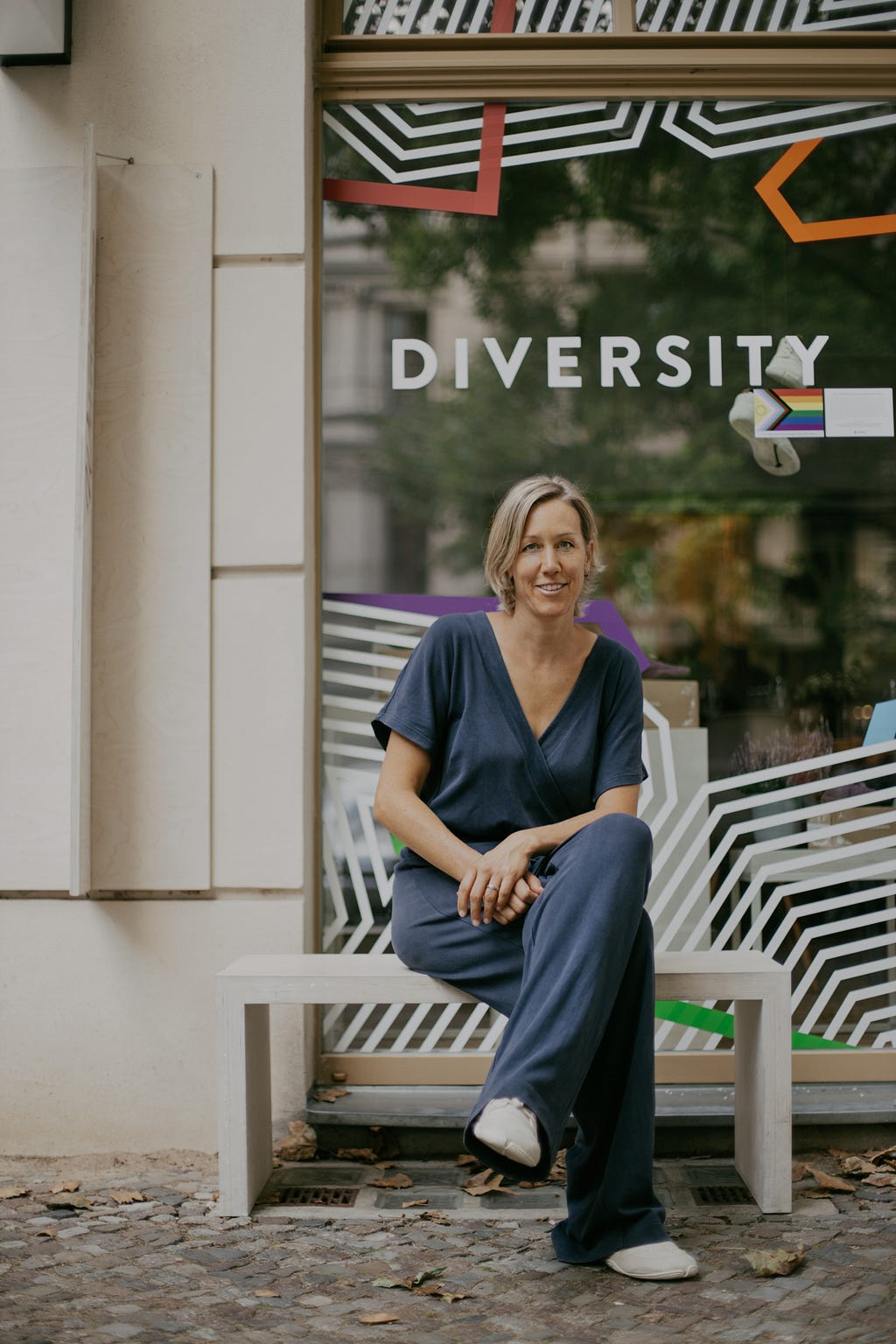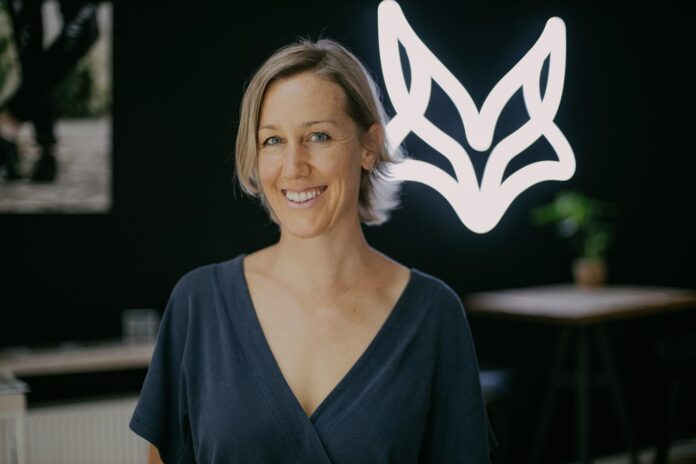Anna Yona Of Wildling: 5 Things We Must Do To Inspire The Next Generation About Sustainability And The Environment
An Interview With Martita Mestey
Lead by example and let them participate.
As part of my series about what we must do to inspire the next generation about sustainability and the environment, I had the pleasure of interviewing Anna Yona.
Anna and Ran Yona founded the company Wildling Shoes in 2015. After Anna completed her degree in Middle Eastern Studies and English literature at Tel Aviv University, she worked in marketing, as a freelance translator and journalist. The couple initially remained rooted in Israel. Their three children grew up barefoot there before the family moved to Germany in 2013. At that point, finding suitable shoes for kids who were used to running around barefoot became the biggest challenge. None of the models seemed to meet the requirements in terms of freedom of movement, sustainable materials, and fair production. And that’s how the idea of Wildling Shoes was born.
Thank you so much for doing this with us! Our readers would love to “get to know you” a bit more. Can you tell us a bit about how you grew up?
I grew up in the hilly German countryside, in a 200-year-old manor house that my parents had saved from ruins and modestly renovated. The house was situated right at the edge of the forest, a little brook running alongside it, the next village a mile off. School was easy for me, but I did not enjoy the strict framework, so I relished in my freedom once school was over and spent the rest of my days outdoors — playing in the brook, climbing trees, exploring caves, or roaming the forests with the neighbors’ dog and ponies. I could get fully immersed in the nature surrounding us, being led by the flow of the moment, intensely experiencing the here and now. Until today, no matter how stressed I am, the moment I step out of the house and into the forest, I calm down completely.
Was there an “aha moment” or a specific trigger that made you decide you wanted to become an environmental leader? Can you share that story with us?
I cannot remember any specific moment, but I think because of the way I grew up, surrounded by nature, I became intensely aware that we are all one. There are no human beings and some kind of separate “environment” that surrounds us. We are all made up of the same elementary building blocks, we are all mutually dependent on each other. Life is a constant cycle of giving and taking, and when we drive this out of balance by taking too much for too long, we are ultimately hurting ourselves. I believe that we all feel this pain. For me, only action can give some relief, so I am trying to make activism part of my professional life.
Is there a lesson you can take out of your own story that can exemplify what can inspire a young person to become an environmental leader?
I believe the most important thing is to go out there and get immersed in nature. We cannot love what we don’t know intimately, so putting our cell phones aside and leaving our homes to explore the outdoors is essential. Another important thing is to experience self-efficacy — to see that your actions can cause a change. This can start with small things, such as holding a presentation in school or signing a petition. It can mean taking action in your community, organizing, and supporting climate justice activities or similar causes. Very often, acting relieves that oppressing feeling of helplessness or anxiety that many experience in the face of the multiple crises and challenges of this time. It can be the starting point of finding strength in the power of collaboration and in turning that helplessness into something useful and meaningful.
Can you tell our readers about the initiatives that you or your company are taking to address climate change or sustainability?
Our goal and purpose as an organization is to find ways to minimize harm and have a positive impact through our actions. The aim is not to conserve and sustain the status quo, but to regenerate, to leave things behind in a better state than in which we have found them. This concerns all areas of our organization — the entire supply chain, our partnerships, and collaborations, the team, as well as the money that Wildling generates and how it can distribute it more fairly. And last but not least, of course, we also focus on the ties with our customers and the impact we can have on their health and well-being. For guidance, we look at how a well-balanced ecosystem functions and to try to adapt our way of thinking and our actions to those principles. Circular, collaborative, diverse, and regenerative — that is what the future looks like for Wildling.
Can you share 3 lifestyle tweaks that the general public can do to be more sustainable or help address the climate change challenge?
Buying secondhand or vintage clothing is an excellent way to reduce waste and save resources. It reduces the demand for new clothing production, which uses a lot of water, energy, and other resources. You can find unique pieces of clothing, save money, and reduce your carbon footprint.
When shopping for new clothes, I look for items made from sustainable materials, such as organic cotton, linen, hemp, and bamboo. These materials use fewer pesticides, herbicides, and chemicals and require less water than conventional cotton.
But before I even buy a new piece, I think about whether I can repair or upcycle something I already have. Repairing and upcycling reduce waste and save money. Instead of throwing away clothes with small tears, missing buttons, or broken zippers, consider repairing them yourself or taking them to a tailor. You can also upcycle clothing by turning them into something new, such as turning an old T-shirt into a tote bag or a pair of jeans into shorts. This way, you can reduce the demand for new clothing production while also expressing your creativity.

Ok, thank you for all that. Here is the main question of our interview: The youth-led climate strikes of September 2019 showed an impressive degree of activism and initiative by young people on behalf of climate change. This was great, and there is still plenty that needs to be done. In your opinion, what are 5 things parents should do to inspire the next generation to become engaged in sustainability and the environmental movement?
1 and 2) Paint a positive image of humankind and kindle optimism.
The most important thing we can teach our kids is how to look at human nature. Are we really the competitive, selfish, and short-sighted species that we are so often portrayed to be? Or are we rather inherently kind, solidary, and able to solve the huge challenges we are faced with, by tackling these problems together, sharing our knowledge, and striving for the benefit of all? I believe the latter holds true. This idea of humankind will lead us and our children to create better relationships — between family and friends, in a work environment, in societies, and ultimately for the global future.
3 and 4) Name the culprit and take it down.
What stands in our way are systems designed to suit an outdated kind of society — selfish and competitive. Within these systems — as we can well see, if we look at the “winners” of our society — egocentrism, greed and a craving for power often lead to a concentration of power and money, which in turn generate more power and money. We have to show our kids that these systems are not a law of nature but man-made (in the true sense of the word). And that they can be changed and improved, where they have shown to be deficient or simply out of date. This way we can create the framework for a more diverse, inclusive, just, and sustainable society.
5) Lead by example and let them participate.
Kids learn most through imitation and participation. We try to include our children in our world of thought and action. At the dinner table, we often talk about current politics and the state of the world, things that are going on in our heads, things we are working on, or questions that we ourselves have been unable to solve, yet. We try to keep an optimistic view and always look at what can be done, instead of what cannot be done. That way, I hope, the children will not be overwhelmed by the magnitude of challenges we’re all faced with but will learn to tackle what they can change first and draw hope and energy from that for the next bigger task.
How would you articulate how a business can become more profitable by being more sustainable and more environmentally conscious? Can you share a story or example?
I believe first of all we need to redefine success. Is that really best measured in monetary terms — in other words, profit — or are there other indicators that can spell success even better?
Of course, a company needs to be able to pay its bills, and fair wages to the people it employs. The impact a company can have also directly depends on the financial resources available to fund a project or invest in sustainable improvement. However, in the end, I would always rate a beneficial impact on our social and ecological environment as the highest indicator of success.
Ultimately this will translate to “conventional”, economic success, too. If your team feels safe, motivated, and committed, this will take the company as a whole further. Treating all your partners as equals is the basis for long-lasting, reliable relationships that will create high-quality goods. A brand that stands up for its values and is committed to meaningful change inspires a strong identification with the company and its cause and therefore creates a loyal customer base.
None of us are able to achieve success without some help along the way. Is there a particular person who you are grateful towards who helped get you to where you are? Can you share a story about that?
Building an organization is first and foremost about shaping relationships with many different people that will teach you something or help you — even with a little gesture — when you most need it. So, it’s hard to pinpoint one story.
But for me as a female founder and mother, the one person who helped me most along the way is my husband and co-founder, Ran. Since our three kids were still quite young when we started the business, him taking over the giant share of the family management was essential for me to be able to focus on Wildling. At the same time, he has always had a clear vision and very good intuition of how the product, brand, and customer relations should develop. It is not always easy to be both — husband and wife as well as business partners but knowing that we can entirely rely on each other is invaluable.
What is the best way for people to follow you on social media?
You can view our minimal shoes here: https://us.wildling.shoes ! Follow us on IG @wildling.shoes, FB Wildling Shoes, and my journey @annawildling.
This was so inspiring. Thank you so much for joining us!
Anna Yona Of Wildling: 5 Things We Must Do To Inspire The Next Generation About Sustainability And… was originally published in Authority Magazine on Medium, where people are continuing the conversation by highlighting and responding to this story.


